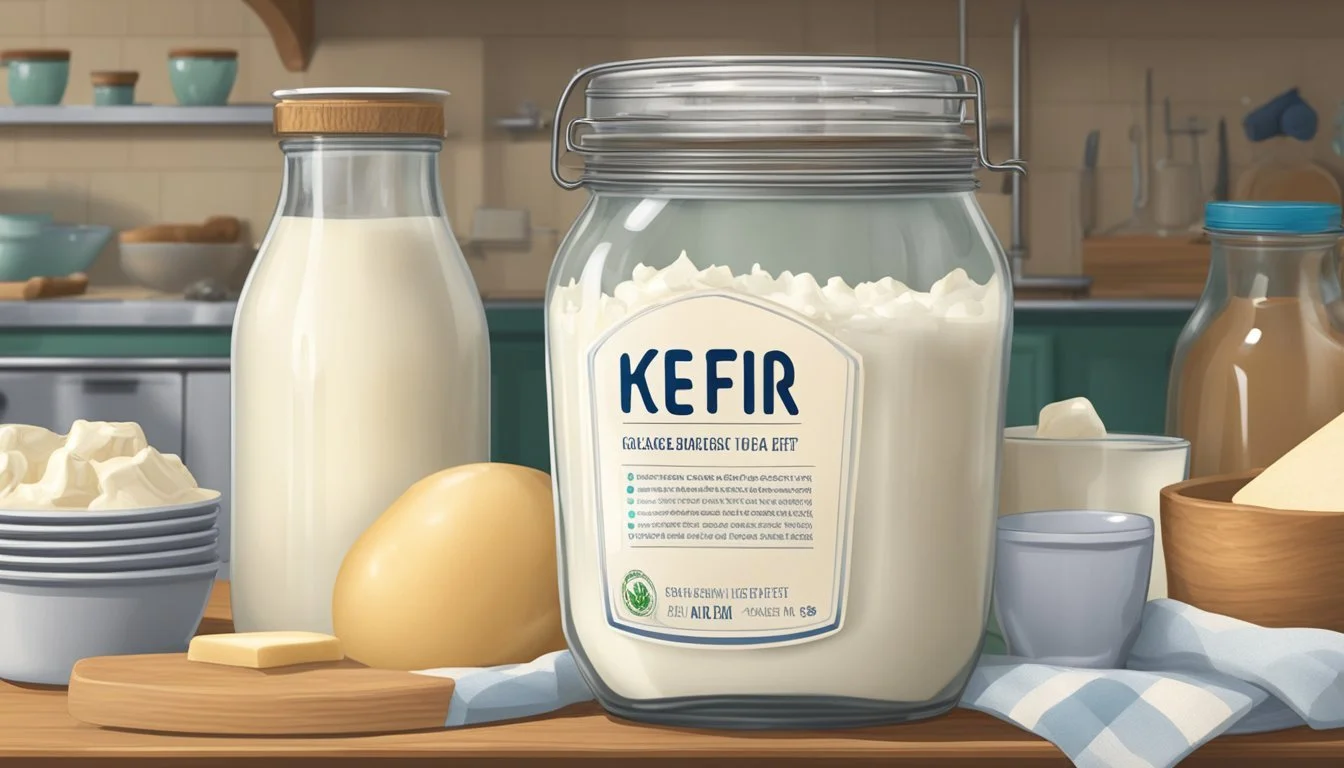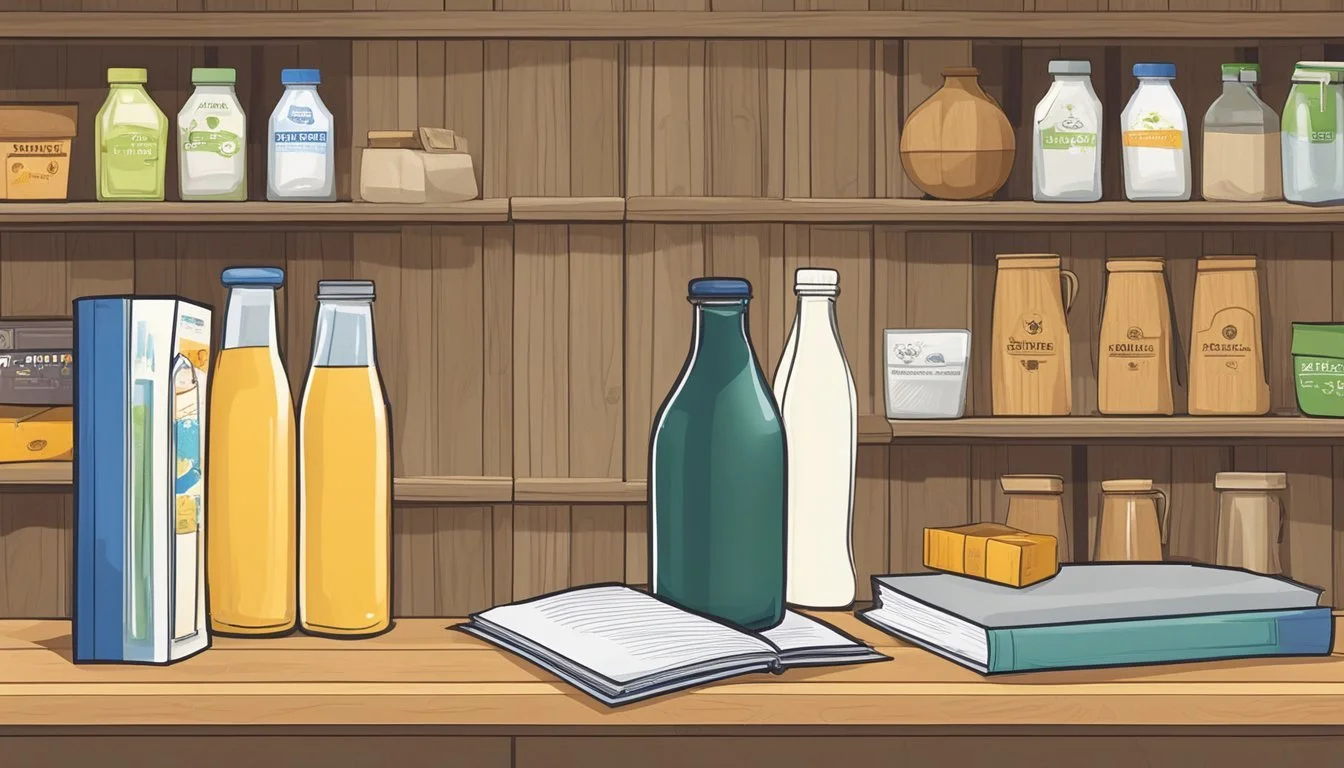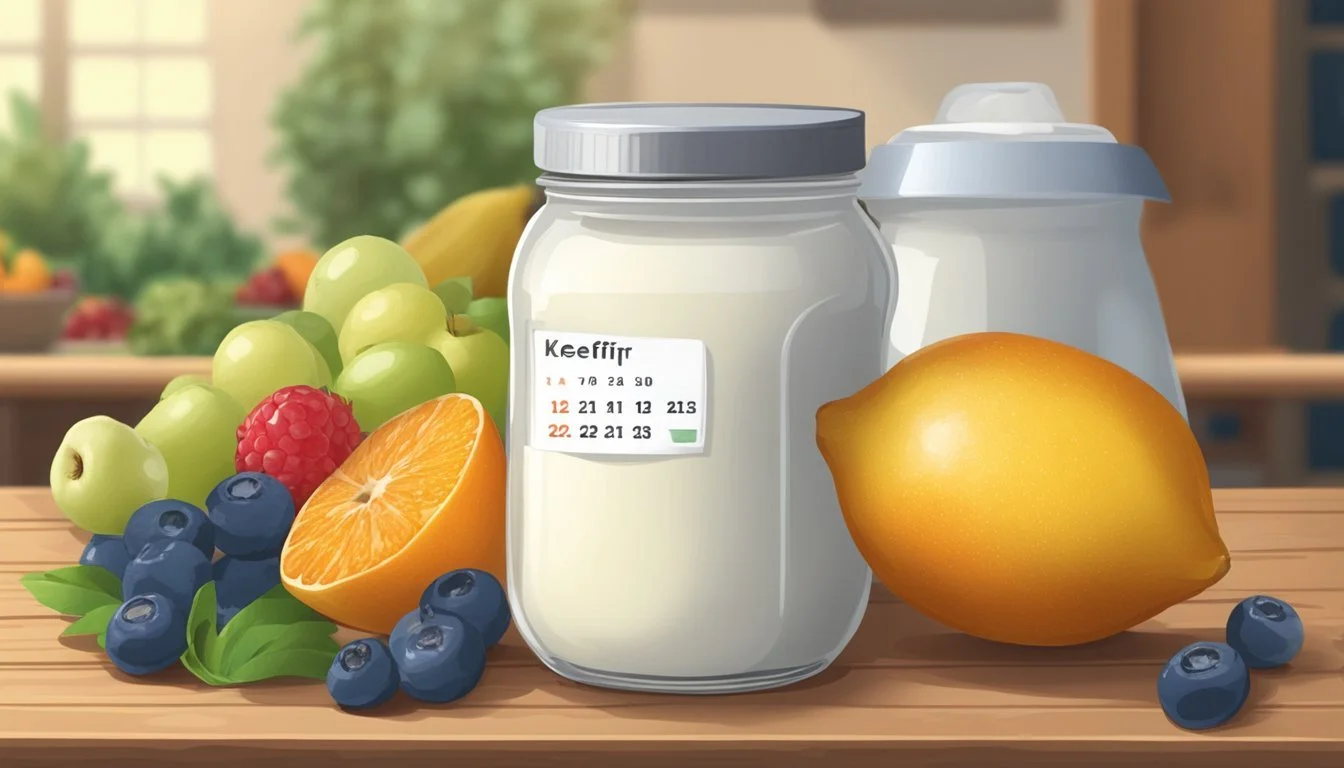How Long Does Kefir Last?
Shelf Life and Storage Tips
Kefir, a fermented dairy beverage known for its probiotic properties, has gained popularity for its health benefits. However, there's often a question of how long it can be safely consumed after purchase or preparation. Kefir's shelf life depends on various factors, including its preparation method—whether it is homemade or store-bought—how it is stored, and whether or not the container has been opened.
When unopened and stored in the refrigerator, commercial kefir usually stays good for a period exceeding its sell-by date by at least a week. Once opened, it is recommended to drink it within three to five days to ensure quality and safety. Homemade kefir has a shorter shelf life at room temperature, lasting around one to two days, but can last up to a few weeks when refrigerated properly.
Signs of spoilage in kefir include an off sour smell, the presence of mold, or an unpleasant sour taste. Consumers should inspect their kefir before consumption to ensure it has not gone bad, as spoiled kefir may lead to illness. Proper storage methods involve refrigeration and, for longer shelf life, kefir can also be stored in the freezer.
Understanding Kefir
This section delves into kefir: a probiotic-rich fermented drink beneficial for digestion and bone health due to its abundance of bacteria, yeast, nutrients, and minerals.
What Is Kefir?
Kefir is a cultured, fermented milk beverage that boasts a tart, slightly acidic flavor and a consistency comparable to thin yogurt. It’s made by adding kefir grains, which are a symbiotic culture of bacteria and yeast, to milk and allowing it to ferment. The fermentation process typically takes around 24 hours.
Kefir Vs. Yogurt
While both kefir and yogurt are fermented dairy products rich in probiotics, kefir contains a more diverse and numerous array of live bacteria and yeast. Yogurt often has a thicker consistency, whereas kefir is drinkable. Kefir also typically has a greater variety of probiotics, which enhances its gut health benefits.
Kefir Grains and Culturing
Kefir grains consist of a gelatinous cluster of microorganisms, primarily including lactic acid bacteria and yeasts. In the culturing process, these grains are placed in milk, where they multiply and ferment the lactose into lactic acid, creating the unique kefir beverage. These grains are then removed before consumption and can be reused for subsequent fermentations.
Types of Kefir
There are primarily two types of kefir: dairy-based and dairy-free. Dairy-based kefir is made with cow, goat, or sheep milk, while dairy-free alternatives, such as coconut milk kefir, use plant-based liquids, offering options for those avoiding lactose or dairy.
Health Benefits of Kefir
Kefir is recognized for its probiotic content, which supports gut health by balancing the intestinal flora. The beverage is rich in nutrients such as calcium, phosphorus, and vitamins that aid in bone health. Regular consumption of kefir can also promote digestion and may improve the immune response.
Shelf Life Fundamentals
Understanding the shelf life of kefir is paramount for ensuring its freshness and safety for consumption. This involves knowing what ‘shelf life’ means and the factors that influence how long kefir remains viable.
Defining 'Shelf Life'
'Shelf Life' refers to the duration a product, in this case kefir, remains suitable for consumption after production. This timespan encompasses the period during which the product retains its desired qualities, such as flavor, nutritional value, and texture.
Factors Affecting Kefir's Shelf Life
Several factors contribute to the longevity of kefir's shelf life:
Fermentation Process: Kefir is a fermented milk drink, which means it is created by adding a culture of yeasts and bacteria to milk. This culture transforms the milk's sugars into acids, carbon dioxide, and other compounds, a process which acts as a natural preservative.
Microorganisms: The specific strains of bacteria and yeasts involved in making kefir not only contribute to its unique taste but also to how well it preserves over time.
Temperature: Storage temperature plays a crucial role. Kefir should be stored in a refrigerator to maintain its quality. The ideal temperature range to maximize kefir's shelf life is between 1°C and 4°C (34°F and 39°F).
Expiry Date: Commercially packaged kefir comes with an expiration date, which should be adhered to as a guideline for safe consumption.
Storage Conditions: Exposure to higher temperatures, such as room temperature, accelerates the growth of microorganisms, potentially leading to spoilage before the printed expiry date. Kefir should be kept in a tightly closed container to avoid contamination and should not be left out at room temperature for extended periods.
Proper Storage Practices
Maximizing kefir's shelf life involves maintaining optimal storage conditions, proper care for opened products, specialized handling of homemade kefir, and selecting the right containers.
Optimal Storage Conditions
The secret to prolonging kefir's freshness lies in refrigeration. Kefir should be stored at a temperature between 32°F (0°C) and 40°F (4°C) to slow down fermentation. Keeping it away from direct sunlight also helps in preserving its quality.
Storing Opened Kefir
Once opened, kefir must be kept in an airtight container to prevent contamination. Plastic or glass jars are both suitable, but they must seal properly. The shelf life of opened kefir in the refrigerator extends up to two weeks.
Storing Homemade Kefir
Homemade kefir, often made with pasteurized milk, tends to last 1-2 weeks when refrigerated. It's crucial to ensure it is covered and placed in the coldest part of the fridge, away from the door where temperature fluctuations are common.
The Role of Containers in Storage
Containers play a vital role in kefir storage. Whether plastic or glass, they should be airtight to protect the kefir from unwanted bacteria and odors. While freezing kefir is an option, it may alter the texture and is not generally recommended for optimal taste and probiotic benefits.
Identifying Spoilage
The telltale signs of spoilage in kefir are primarily changes in its smell, taste, and texture. Recognizing these signs is crucial to avoid potential health risks associated with consuming spoiled products.
Signs of Spoiled Kefir
Spoiled kefir typically exhibits a sour smell and sour taste that are more intense than the usual tangy aroma and flavor characteristic of fresh kefir. The texture may become unusually thick and the kefir can appear separated, with clear liquid at the bottom and a thicker layer on top. Visible mold or any discoloration suggests microbial contamination and should be taken as a clear indication that the kefir is no longer safe to consume.
Smell: An intense sour or off aroma.
Taste: A taste that is excessively sour compared to the typical mild sourness of fresh kefir.
Texture: Thickening beyond the normal consistency or the presence of separation.
Visual: Any signs of mold or unusual colors.
Effects of Spoilage on Health
Consuming spoiled kefir can lead to foodborne illnesses, as the product may contain pathogens resulting from microbial contamination. Symptoms may include diarrhea, abdominal discomfort, nausea, and vomiting. It is important to note that the risk of illness increases with the presence of mold, which can produce harmful toxins. For safety, it is recommended to discard any kefir that shows signs of spoilage.
Microbial Contamination: Can lead to foodborne illness.
Presence of Mold: Mold can produce toxins that are hazardous to health.
Safety: Spoiled kefir should not be consumed and must be discarded to prevent health risks.
Maximizing Kefir Freshness
Proper storage and handling are critical for maintaining the freshness and optimal flavor of kefir. This section outlines specific strategies one can employ to keep kefir at its best from batch to batch.
Freshness Tips
Inspect Expiration Dates: Always check the expiry date on commercial kefir and plan to consume it before this date.
Store Correctly: Kefir should be stored in the refrigerator at or below 40°F (4°C) to slow down the fermentation process and preserve its freshness.
Seal Tightly: After opening or during storage of homemade kefir, ensure that the container is sealed tightly to preserve its flavors and prevent contamination.
Making Kefir Last Longer
Observe Fermentation: Homemade kefir's fermentation process should be monitored. Kefir that has fermented too long may have an overly strong taste.
Batch Maintenance: Rotate your stock by using the oldest batch of kefir first and properly label new batches with the date of production.
Optimal Consumption: For best taste, consuming homemade kefir within two weeks and store-bought kefir within one week of opening is advisable, even if the expiration date is further away.
Utilizing Expired Kefir
When kefir passes its expiration date, it may still have viable uses. These uses depend on the extent of sourness and the absence of spoilage signs such as mold and off-odors.
Culinary Uses for Expired Kefir
Expired kefir can often be incorporated into recipes. Its increased sourness lends well to baked goods, as it can act similarly to buttermilk, enhancing the texture and flavor. Baking with expired kefir can include making fluffy pancakes, cakes, or even yeasted breads where the slight tang of kefir can be a delicious addition.
Recipes: Use expired kefir in place of buttermilk or yogurt in baking recipes for added flavor.
Baking: Bread, pancakes, and muffins gain a pleasant texture and a slightly tangy taste with expired kefir.
One should, however, ensure the kefir hasn’t developed mold or a distinctly unpleasant odor, as this indicates spoilage, and it should not be consumed.
Non-Culinary Uses
Beyond the kitchen, expired kefir can contribute to the health of one's garden. The probiotics in kefir can act similarly to products like sauerkraut or kombucha, which are sometimes used in composting to accelerate the breakdown of organic matter. By blending expired kefir with water, it can be applied as a soil amendment, providing beneficial bacteria that promote plant growth.
Garden: Add diluted expired kefir to compost or directly to soil as a probiotic booster.
Houseplants: Use expired kefir diluted with water to feed household plants, ensuring beneficial microorganisms enrich the potting soil.
FAQs on Kefir Longevity
Understanding the shelf life of kefir and the factors that influence it is essential for both avid kefir drinkers and beginners. This section answers common questions about how long kefir lasts and how to tell if it has gone bad.
Commonly Asked Questions
How long does store-bought kefir last?
Unopened, store-bought kefir can last for 1-2 weeks past its printed date when refrigerated properly at temperatures between 32°F and 39°F.
Once opened, it should be consumed within two weeks for optimal taste, although it may remain safe to consume for a few extra days.
Can the shelf life of kefir be extended?
To extend its shelf life, store kefir in its original sealed container.
The use of stainless steel equipment for fermenting can prevent contamination and preserve the kefir's quality longer.
Is homemade kefir different in terms of longevity?
Homemade kefir, when refrigerated, can stay fresh for up to 2-4 weeks depending on the ingredients and environment.
For those using non-dairy bases like coconut milk, the shelf life might differ; one should observe the kefir and use it while it's fresh.
How does one know if kefir has gone bad?
Signs of spoilage include an overly sour smell, change in texture, and presence of mold. Kefir that has separated into whey and curds, however, can still be good if it smells fine.
What about water kefir?
Water kefir made with sugar water or juice generally lasts around 2-3 weeks if kept refrigerator. Again, factors like temperature and container seal affect longevity.
Can kefir be left dormant?
Kefir grains can be made dormant by storing them in fresh milk and refrigerating for up to a week. Beyond this, feeding the grains fresh milk or sugar water is necessary.
Kefir Storage Myths Debunked
The longevity of kefir often falls prey to misconceptions. This section aims to clarify common storage myths, ensuring consumers can enjoy this fermented dairy product safely and at its best quality.
Popular Storage Myths
Myth: Kefir Cannot Be Frozen
Fact: Freezing kefir is possible and can extend its shelf life. However, it's important to remember that while freezing may affect the consistency, the beneficial bacteria in milk kefir typically remain intact after thawing.
Myth: Thawed Kefir Loses Its Probiotic Benefits
Fact: Thawed kefir retains most of its probiotic properties. The process of freezing may slow down the activity of beneficial bacteria, but they become active again once thawed.
Myth: Kefir Lasts Indefinitely Due to Fermentation
Fact: Though fermentation does prolong the shelf life of kefir compared to regular milk, it does not make it immune to spoilage. Kefir has a specific shelf life and should be consumed within this timeframe for optimal freshness and taste.
Myth: Kefir's Taste Does Not Change Over Time
Fact: The taste of kefir can become more tangy or sour over time, especially if it comes from traditional sources in Eastern Europe or Russia where methods may vary. Consumers should expect a natural progression in flavor due to ongoing fermentation.
Myth: Buttermilk and Kefir Have the Same Storage Requirements
Fact: Though both are fermented dairy products, kefir and buttermilk may have different storage guidelines. Kefir typically has a longer shelf life, given its unique fermentation process and microbial composition.







